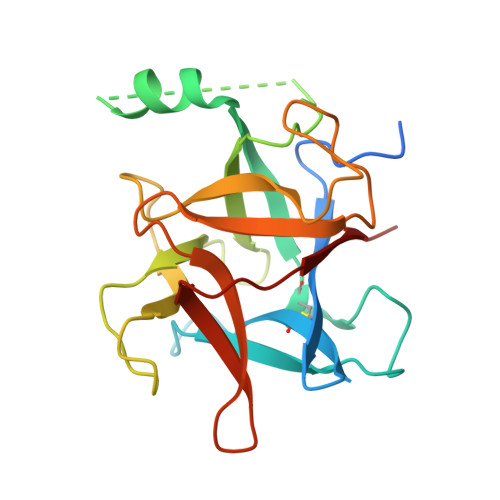Crystal structure of ryanodine receptor N-terminal domain from Plutella xylostella reveals two potential species-specific insecticide-targeting sites.
Lin, L., Liu, C., Qin, J., Wang, J., Dong, S., Chen, W., He, W., Gao, Q., You, M., Yuchi, Z.(2017) Insect Biochem Mol Biol 92: 73-83
- PubMed: 29191465
- DOI: https://doi.org/10.1016/j.ibmb.2017.11.009
- Primary Citation of Related Structures:
5Y9V - PubMed Abstract:
Ryanodine receptors (RyRs) are large calcium-release channels located in sarcoplasmic reticulum membrane. They play a central role in excitation-contraction coupling of muscle cells. Three commercialized insecticides targeting pest RyRs generate worldwide sales over 2 billion U.S. dollars annually, but the structure of insect RyRs remains elusive, hindering our understanding of the mode of action of RyR-targeting insecticides and the development of insecticide resistance in pests. Here we present the crystal structure of RyR N-terminal domain (NTD) (residue 1-205) at 2.84 Å resolution from the diamondback moth (DBM), Plutella xylostella, a destructive pest devouring cruciferous crops all over the world. Similar to its mammalian homolog, DBM RyR NTD consists of a beta-trefoil folding motif and a flanking alpha helix. Interestingly, two regions in NTD interacting with neighboring domains showed distinguished conformations in DBM relative to mammalian RyRs. Using homology modeling and molecular dynamics simulation, we created a structural model of the N-terminal three domains, showing two unique binding pockets that could be targeted by potential species-specific insecticides. Thermal melt experiment showed that the stability of DBM RyR NTD was higher than mammalian RyRs, probably due to a stable intra-domain disulfide bond observed in the crystal structure. Previously DBM NTD was shown to be one of the two critical regions to interact with insecticide flubendiamide, but isothermal titration calorimetry experiments negated DBM NTD alone as a major binding site for flubendiamide.
- Tianjin Key Laboratory for Modern Drug Delivery & High-Efficiency, Collaborative Innovation Center of Chemical Science and Engineering, School of Pharmaceutical Science and Technology, Tianjin University, Tianjin 300072, China; State Key Laboratory of Ecological Pest Control for Fujian/Taiwan Crops and Institute of Applied Ecology, Fujian Agriculture and Forestry University, Fuzhou 350002, China; Joint International Research Laboratory of Ecological Pest Control, Ministry of Education, Fuzhou 350002, China; Fujian-Taiwan Joint Centre for Ecological Control of Crop Pests, Fujian Agriculture and Forestry University, Fuzhou 350002, China.
Organizational Affiliation:


















